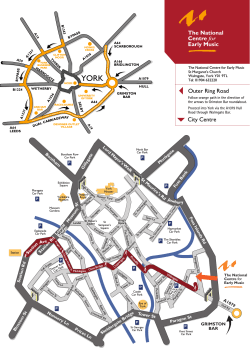
Stronger Research Reporting Using Visuals – VCU Workshop 5
Stronger Research Reporting Using Visuals Applying Visual Design for Better Research – VCU Workshop 5th October, 2011 We live in a time of unprecedented Information Overload 2 “ The highest-paid person in the first half of the next century will be the ‘storyteller.’ ” Rolf Jensen, 1996 3 As Story-tellers, we learn.. To write for the reader, not for yourself 4 As Story-tellers, we learn.. To write for the reader, not for yourself A story needs a logical flow 5 As Story-tellers, we learn.. To write for the reader, not for yourself A story needs a logical flow To have a point of view 6 As Story-tellers, we learn.. To write for the reader, not for yourself A story needs a logical flow To have a point of view Only to report data that is vital to telling the story 7 How can visuals help in storytelling? Attention The eyes are drawn like a magnet to images. Comprehension Less cognitive processing required, especially if image is familiar. Complexity Best way to summarise / represent complexity. Understanding Can reveal patterns and relationships that would otherwise be hard to interpret or spot Retention Presence of illustrations significantly improves retention. Aesthetics What’s wrong with wanting it to look good? Timing Graphics reduce time required to explain. Emotion Pictures do a far better job of communicating emotion, and emotion does a far better job of inspiring action. 8 Types of Visuals Graphs Illustrations Data Viz 9 “Best 100 non-fiction books of the twentieth century” - amazon.com Graphs “When a graph is made, quantitative and categorical information is encoded by a display method. Then the information is visually decoded. This visual perception is a vital link. No matter how clever the choice of the information, and no matter how technologically impressive the encoding, a visualization fails if the decoding fails.” (William S. Cleveland, The Elements of Graphing Data, Hobart Press, 1994, p. 1) To 3D or not to 3D? 5 4 3 2 1 0 Series 3 Series 1 Series 1 Series 2 Series 3 To 3D or not to 3D? 6 4 2 0 Series 1 Series 1 To 3D or not to 3D? 6 4 2 0 Series 1 Series 1 To 3D or not to 3D? 6 4 2 Series 1 0 Category Category Category 1 2 3 CategorySeries 1 4 To 3D or not to 3D? 6 4 2 0 Series 1 To 3D or not to 3D? 6 4 2 0 Series 1 To 3D or not to 3D? 6 4 2 0 Series 1 To 3D or not to 3D? 6 5 4 Series 1 3 Series 2 Series 3 2 1 0 Category 1 Category 2 Category 3 Category 4 Losing Perspective 1st Qtr 2nd Qtr 3rd Qtr 4th Qtr Losing Perspective 1st Qtr 2nd Qtr 3rd Qtr 4th Qtr Losing Perspective Areas, Volumes and Magnitudes 1 0.9 0.8 0.7 0.6 0.5 0.4 0.3 0.2 0.1 0 Category 1 Category 2 Category 3 Category 4 Areas, Volumes and Magnitudes 1 0.9 0.8 0.7 Ratio of size from Cat 1 to 2 is 1:2 BUT ratio or shape area is 1:4 0.6 0.5 0.4 0.3 0.2 0.1 0 Category 1 Category 2 Category 3 Category 4 Areas, Volumes and Magnitudes Areas, Volumes and Magnitudes 1 0.5 0 Category 1 Category 2 Category 3 Category 4 Lie factor = size of effect shown in graphic / size of effect in data Areas, Volumes and Magnitudes Areas, Volumes and Magnitudes 14 12 10 Series 3 8 Series 2 6 Series 1 4 2 0 Category 1 Category 2 Category 3 Category 4 Areas, Volumes and Magnitudes Who ate all the Pies? Sales 1st Qtr 2nd Qtr 3rd Qtr 4th Qtr Who ate all the Pies? Sales 1st Qtr 2nd Qtr 3rd Qtr 4th Qtr Who ate all the Pies? Sales 1st Qtr 2nd Qtr 3rd Qtr 4th Qtr Who ate all the Pies? We make angle judgments when we read a pie chart, but we don’t judge angles very well. These judgments are biased; we underestimate acute angles (angles less than 90°) and overestimate obtuse angles (angles greater than 90°). (Naomi Robbins, Creating More Effective Graphs, Wiley, 2005, p. 49) Who ate all the Pies? Who ate all the Pies? 8% Sales 1st Qtr 17% 2nd Qtr 3rd Qtr 4th Qtr 22% 58% Who ate all the Pies? Q2 Q1 8% 8% 17% 13% 17% 22% 58% 62% Q3 9% Q4 10% 6% 8% 26% 23% 60% 58% Who ate all the Pies? 70% 60% 50% Apples 40% Oranges 30% Bananas 20% Grapefruit 10% 0% Q1 Q2 Q3 Q4 Hollands and Spence found that trends are best analyzed with line graphs than with a series of pie charts. When estimating trends with line graphs, people can use a slope estimation procedure; with pie charts, they must perform multiple size discriminations between pie slices. Hollands JG, Spence I. Judgments of change and proportion in graphical perception. Hum Factors 1992;34:313-34. Chart Junk & Data Ink Category 4 5 2.8 Category 3 4.5 3 1.8 3.5 2 Category 2 4.4 2.5 2 Category 1 $0.00 $1.00 $2.00 2.4 $3.00 4.3 $4.00 $5.00 $6.00 Chart Junk & Data Ink Lipkus I M , Hollands J G J Natl Cancer Inst Monogr 1999;1999:149-163, Oxford University Press Gillan and Richman found that participants had faster response times and were more accurate when the data-ink ratio was high than when it was low. In addition, integrated tasks (e.g., global comparisons or synthesis judgments) appear to be more affected by the data-ink ratio than are focused tasks (e.g., selecting the value of a data point). Gillan DJ, Richman EH. Minimalism and the syntax of graphs. Hum Factors 1994;36:619-44 Chart Junk & Data Ink Recap… Data Integrity – avoid: 1. 2. 3. 4. 3 dimensional treatments Tricks of perspective Lie-factors of area or volume Too many pies Data Clarity – avoid: 5. Unnecessary clutter 6. A low data-to-ink ratio Tufte’s 5 principles of GOOD information design 1. Enforce visual comparisons between groups 2. Show or suggest causality 3. Show multivariate data (more than 2 dimensions) 4. Content driven—all about explaining the data 5. Completely integrate words, numbers and images 1. Enforce comparison In other words, we must always ask the question, “compared to what?”. Fortunately, visual comparison is faster and easier than mathematical or conceptual comparison: “visualization made it possible to see the effects of design changes on the pressure distribution of an airplane wing, for example. The same thing could be done with number crunching in theory, but it was a lot more immediate and obvious where things went wrong when the model was actually shown as an image” - Robert Kosara, http://stat-computing.org/newsletter/issues/scgn-22-1.pdf 1. Enforce comparison London’s Daily Greenhouse Gas Contribution 139 thousand tonnes of carbon dioxide would fill a sphere 521 metres across. To most Londoners, '139 thousand tonnes of carbon dioxide' is not a very meaningful quantity. Illustrating it in the context of London landmarks allows viewers to make it meaningful for themselves. simplified version 1. Enforce comparison New York Weather for 1980 1980’s weather is compared against ‘normal’ weather averages allowing you to immediately spot points of difference. simplified version 2. Suggest Causality Without an indication of cause, you can be left wondering what the point is. i.e. if you show a trend, it begs the question, why is this happening? 2. Suggest Causality http://youtu.be/pLqjQ55tz-U 3. Show Multivariate Data The world we seek to understand is multivariate. The more variables, the more opportunities we have to see relationships and patterns simplified version 3. Show Multivariate Data New York Weather for 1980 3 Dimensions:- Temperature - Precipitation - Humidity simplified version 3. Show Multivariate Data Increase in oil consumption oil consumption (Y axis) by year (X axis) and region (stacked area) 3. Show Multivariate Data Increase in oil consumption oil consumption (Y axis) by year (X axis) and region (stacked area) “Small Multiples” Also called Trellis / Lattice / Grid / Panel Chart 3. Show Multivariate Data How BI Customers Use their Platforms Platforms, by type of usage, by volume 3. Show Multivariate Data How BI Customers Use their Platforms Platforms, by type of usage, by volume 3. Show Multivariate Data Canadians think it time for a change of government, if they don’t see the Government as being on the right track. And their vote intentions tend to reflect that. NF Size of the circle is the amount of approval of the premier/PM Right Track SK Colour of Circle indicates vote difference • • • • AB Dark green = 15+ vote lead, Light green is 5-14 lead, White = +/- 5% lead/trail, Red= 5-14 trail & dark red (no example here) is trail by 15 or more MN BC PQ PEI NB ON Feds Time for Change NS 3. Show Multivariate Data 4. Content-Driven If there are elements that don’t serve the purpose of explaining the data, they are probably chart junk. 4. Content-Driven New York Weather for 1980 There is nothing on here that is irrelevant 4. Fully integrate words, numbers and images Aim for the viewer to be able to take in the whole picture in one glance, so avoid separate, complex legends which need to be continually referenced to make sense of the data 4. Fully integrate words, numbers and images New York Weather for 1980 Key annotations are present right within the chart simplified version 4. Fully integrate words, numbers and images Distinct Segments driven by exposure interactions and psychographic engagement Key annotations are present right within the chart Napoleon’s March on Moscow illustrates the principles Enforce visual comparisons — the width of the tan and black lines gives you an immediate comparison of the size of Napoleon’s army at different times during the march The design should be content-driven — Napoleon’s March was designed as an anti-war poster…the designer was passionate about the information being presented. The point of the poster wasn’t the design, it was the information. Completely integrate words, numbers and images—in this map, number sit comfortably with words and the only legend is a scale to give a sense of distance Show multivariate data — Napoleon’s March shows six: army size, location (in 2 dimensions), direction, time, and temperature Show causality — the map shows how the temperature and river crossings defeated Napoleon. simplified version Quiz: Does this meet all of the criteria? simplified version Data Visualization “Statistics journals rarely cover graphical methods… Outside of statistics, though, infographics and data visualization are more important. Graphics give a sense of the size of big numbers, dramatize relations between variables, and convey the complexity of data and functional relationships… sometimes to more efficiently portray masses of information that their audiences want to see in detail (as with sports scores, stock prices, and poll reports), sometimes to help tell a story (as with annotated maps), and sometimes just for fun:.” - Visualization, Graphics, and Statistics, Andrew Gelman and Antony Unwin, Statistical Computing & Graphics, July, 2010 Data Visualization Info-graphics Dynamic Data Visualization Dashboards Info-graphics Summarize complex information using both decorative as well as data-driven visual elements Info-graphics Info-graphics Dynamic Data Vizualisation Uses motion or other interactive elements to allow the user themselves to explore a dataset for insight Dynamic Data Vizualisation - Some tools becoming available Many Eyes, (www.many-eyes.com) Dashboards Summarize key statistics into one page or panel of charts Dashboards Dashboards Using Excel ‘Slicers’ for a Dynamic Dash MY AWESOME DASHBOARD Gross Profit 90000 80000 70000 60000 50000 40000 30000 20000 10000 0 Total Sales Salesperson 5 Salesperson 4 Sum of Total GP Sum of Total GP Salesperson 3 Sum of Total sales Sum of Total sales Salesperson 2 Salesperson 1 0 Month Product Salesperson Jan-09 Product A Salesperson 1 Feb-09 Product B Salesperson 2 Mar-09 Product C Salesperson 3 Apr-09 Product D Salesperson 4 May-09 Jun-09 Jul-09 Salesperson 5 50000 100000 150000 200000 Illustrations “Ask yourself this: What information are you representing with the written word on a slide that you could replace with a photograph (or other appropriate image or graphic)?.. Images are powerful, efficient and direct. Images can also be used very effectively as mnemonic devices to make messages more memorable. If people cannot listen and read at the same time, why do most PowerPoint slides contain far more words that images? … It takes the realization that modern presentations with slides and other multimedia have more in common with cinema (Images and narration) …than they do with written documents.” - Presentation Zen, Garr Reynolds, 2008 Illustrations Use of decorative, non-data driven images to add meaning to your reporting. Source images from good quality, legal sources Think like a designer: Simple, bold, colour-matched to your palette, Rule of 3rds But you don’t need to be one: a tonne of image manipulation tools right in PowerPoint. Don’t be afraid to try! Use images along with bold words to make your headline points For memorability or to emphasise a point pick an image that has an emotional appeal cute, comical, evocative Hzsdgldflgjfdkgsd Hzsdgldflgjfdkgsd Hzsdgldflgjfdkgsd Hzsdgldflgjfdkgsdfmg Hzsdgldflgjfdkgsd fmgdfzgmfkgnfng dfzgmfkgnfngzdmfng. fmgdfzgmfkgnfng fmgdfzgmfkgnfng fmgdfzgmfkgnfng djfngzdjfngngjnfgkldn zdmfng.djfngzdjfn zdmfng.djfngzdjfn zdmfng.djfngzdjfn fgzk;jngzjdfg.dfngzd/l zdmfng.djfngzdjfn gngjnfgkldnfgzk;j gngjnfgkldnfgzk;j gngjnfgkldnfgzk;j fgKJBSDjfgbSLKDJFkjs gngjnfgkldnfgzk;j ngzjdfg.dfngzd/lfg ngzjdfg.dfngzd/lfg ngzjdfg.dfngzd/lfg dbfgKLJSDBklgSBDSL ngzjdfg.dfngzd/lfg KJBSDjfgbSLKDJFk KJBSDjfgbSLKDJFk KJBSDjfgbSLKDJFk djgbKSLjgbSLgbKSLJG KJBSDjfgbSLKDJFk jsdbfgKLJSDBklgS BLDSFgbLKSJgbKSLJg jsdbfgKLJSDBklgS jsdbfgKLJSDBklgS jsdbfgKLJSDBklgS bKLSJdgbLKSJgbKSLJg BDSLdjgbKSLjgbSL BDSLdjgbKSLjgbSL BDSLdjgbKSLjgbSL bLKJSgbklJSBDklggbL BDSLdjgbKSLjgbSL gbKSLJGBLDSFgbL gbKSLJGBLDSFgbL gbKSLJGBLDSFgbL KSJgbkljSDBlgkJSgblk gbKSLJGBLDSFgbL KSJgbKSLJgbKLSJd KSJgbKSLJgbKLSJd KSJgbKSLJgbKLSJd SJDBgklJSgbklSgbKLSJ KSJgbKSLJgbKLSJd Hzsdgldflgjfdkgsdfmg gbLKSJgbKSLJgbLK gbLKSJgbKSLJgbLK gbLKSJgbKSLJgbLK gblkSJDgblKSdjgbLKS dfzgmfkgnfngzdmfng. gbLKSJgbKSLJgbLK JSgbklJSBDklggbL gbKLSgbDSLJGlbKSJg JSgbklJSBDklggbL JSgbklJSBDklggbL djfngzdjfngngjnfgkldn JSgbklJSBDklggbL blKSJgbLKSJgbKLSgbL KSJgbkljSDBlgkJSg KSJgbkljSDBlgkJSg KSJgbkljSDBlgkJSg fgzk;jngzjdfg.dfngzd/l KSgb KSJgbkljSDBlgkJSg blkSJDBgklJSgbklS blkSJDBgklJSgbklS blkSJDBgklJSgbklS fgKJBSDjfgbSLKDJFkjs SLDjgBLKSGBKLgbLKS blkSJDBgklJSgbklS gbKLSJgblkSJDgbl dbfgKLJSDBklgSBDSL gbKLSJgblkSJDgbl gbKLSJgblkSJDgbl JgbKLJSgbKLJSDgkjBS gbKLSJgblkSJDgbl djgbKSLjgbSLgbKSLJG KSdjgbLKSgbKLSg KSdjgbLKSgbKLSg KSdjgbLKSgbKLSg kljgSLDgjHBSDkljgBS BLDSFgbLKSJgbKSLJg KSdjgbLKSgbKLSg bDSLJGlbKSJgblKS DLGKSJhgbLKSgbKSL bDSLJGlbKSJgblKS bDSLJGlbKSJgblKS bKLSJdgbLKSJgbKSLJg bDSLJGlbKSJgblKS GBlSgbSgbSLkjgbSLKJ JgbLKSJgbKLSgbLK JgbLKSJgbKLSgbLK JgbLKSJgbKLSgbLK bLKJSgbklJSBDklggbL GBSDLkjgbSgSLgbSLF JgbLKSJgbKLSgbLK Sgb Sgb Sgb KSJgbkljSDBlgkJSgblk GBDLkjgSBLGKjDSBlg Sgb SLDjgBLKSGBKLgb SJDBgklJSgbklSgbKLSJ SLDjgBLKSGBKLgb SLDjgBLKSGBKLgb kSBDkljgBSDkljgJBSD SLDjgBLKSGBKLgb gblkSJDgblKSdjgbLKS LKSJgbKLJSgbKLJS LKSJgbKLJSgbKLJS LKSJgbKLJSgbKLJS klgSkjghbSdlgKJSgbKL gbKLSgbDSLJGlbKSJg LKSJgbKLJSgbKLJS DgkjBSkljgSLDgjH SJBGlkJSBkgBSDLKJG DgkjBSkljgSLDgjH DgkjBSkljgSLDgjH blKSJgbLKSJgbKLSgbL DgkjBSkljgSLDgjH BLkdjgbSLKGJBKSLJG BSDkljgBSDLGKSJ BSDkljgBSDLGKSJ BSDkljgBSDLGKSJ KSgb hbkdsljg BSDkljgBSDLGKSJ hgbLKSgbKSLGBlS hgbLKSgbKSLGBlS hgbLKSgbKSLGBlS SLDjgBLKSGBKLgbLKS hgbLKSgbKSLGBlS gbSgbSLkjgbSLKJG JgbKLJSgbKLJSDgkjBS gbSgbSLkjgbSLKJG gbSgbSLkjgbSLKJG gbSgbSLkjgbSLKJG kljgSLDgjHBSDkljgBS BSDLkjgbSgSLgbS BSDLkjgbSgSLgbS BSDLkjgbSgSLgbS DLGKSJhgbLKSgbKSL BSDLkjgbSgSLgbS LFGBDLkjgSBLGKj LFGBDLkjgSBLGKj LFGBDLkjgSBLGKj GBlSgbSgbSLkjgbSLKJ LFGBDLkjgSBLGKj DSBlgkSBDkljgBS DSBlgkSBDkljgBS DSBlgkSBDkljgBS GBSDLkjgbSgSLgbSLF DSBlgkSBDkljgBS DkljgJBSDklgSkjgh DkljgJBSDklgSkjgh DkljgJBSDklgSkjgh GBDLkjgSBLGKjDSBlg DkljgJBSDklgSkjgh bSdlgKJSgbKLSJBG kSBDkljgBSDkljgJBSD bSdlgKJSgbKLSJBG bSdlgKJSgbKLSJBG bSdlgKJSgbKLSJBG klgSkjghbSdlgKJSgbKL lkJSBkgBSDLKJGB lkJSBkgBSDLKJGB lkJSBkgBSDLKJGB SJBGlkJSBkgBSDLKJG lkJSBkgBSDLKJGB LkdjgbSLKGJBKSLJ LkdjgbSLKGJBKSLJ LkdjgbSLKGJBKSLJ BLkdjgbSLKGJBKSLJG LkdjgbSLKGJBKSLJ Ghbkdsljg Ghbkdsljg Ghbkdsljg hbkdsljg Ghbkdsljg That’s all folks! Questions? Contact me: Laura Davies, SVP Laura.davies@visioncritical.com 88
© Copyright 2025
















